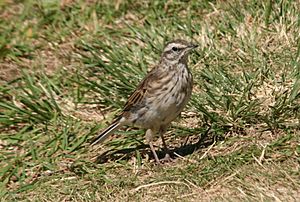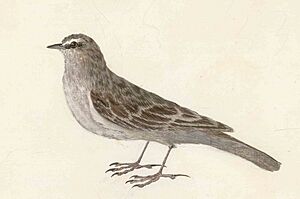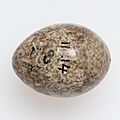New Zealand pipit facts for kids
Quick facts for kids New Zealand pipit |
|
|---|---|
 |
|
| On Kapiti Island | |
| Conservation status | |
| Scientific classification | |
| Genus: |
Anthus
|
| Species: |
novaeseelandiae
|
The New Zealand pipit (Anthus novaeseelandiae) is a small bird found in New Zealand and its nearby islands. It's often called pīhoihoi by Māori people. This bird loves open spaces like grasslands and farms. It belongs to a group of birds called pipits, which are known for walking and running on the ground.
For a long time, the New Zealand pipit was thought to be the same species as several other pipits found in places like Australia and Africa. But now, most scientists agree that the New Zealand pipit is its own unique species.
Contents
Meet the New Zealand Pipit

The New Zealand pipit is a slender bird, usually about 16 to 19 centimeters (about 6 to 7.5 inches) long. It weighs around 40 grams, which is about as much as a small candy bar!
Its feathers are pale brown on top with darker streaks, helping it blend in with its surroundings. Its belly is lighter, also with some streaks on its chest. You might notice a light stripe above its eye and dark stripes on its cheeks. The pipit has a long tail with white feathers on the sides, which it often wags up and down. It has long, pinkish-brown legs and a thin, brownish bill.
Where Pipits Live and What They Eat
The New Zealand pipit prefers open areas. You can often spot them in grasslands, farmlands, along roadsides, in dry riverbeds, on sand dunes, and in open woodlands.
These birds are ground feeders. They walk around looking for small invertebrates to eat, such as beetles, spiders, and insect larvae (like caterpillars). They also enjoy eating seeds, especially those from grasses.
Sadly, the number of New Zealand pipits has gone down in some areas. This is partly because of changes to farmlands, the use of pesticides, and predators like introduced species (animals brought to New Zealand by people).
Pipit Family Members
Scientists have identified four different types, or subspecies, of the New Zealand pipit. These subspecies are found in different parts of New Zealand and its surrounding islands:
- A. n. novaeseelandiae: Found on the North, South, and Stewart Islands.
- A. n. chathamensis: Lives on the Chatham Islands, east of New Zealand's South Island.
- A. n. aucklandicus: Found on the Auckland and Campbell Islands, south of the South Island.
- A. n. steindachneri: Lives on the Antipodes Islands, southeast of Stewart Island.
Images for kids
-
A New Zealand pipit A. n. aucklandicus on Campbell Island
-
Anthus novaeseelandiae egg in the collection of Auckland Museum





